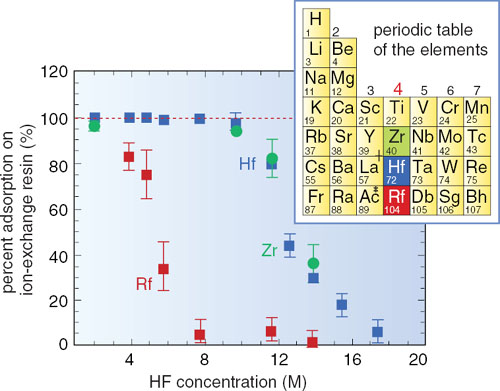In the periodic table of the elements, the elements placed in the same column are said to belong to the same group, and they usually show similar chemical properties. However, for the case of superheavy elements, it has been pointed out that they have a theoretical possibility of showing properties which differ from the periodic law. Up to now, we have knowledge of over 110 chemical elements. However, the study of the chemical properties of the superheavy elements has been severely limited by their short half-lives and small production rate.
Element 104, rutherfordium (Rf), which marks the beginning of the superheavy elements, is sure to be an element belonging to the 4th group in the periodic table. In order to study the chemical properties of Rf, any chemistry to be performed must be done with single atoms on a "one-atom-at-a time" basis. Thus, rapid, highly efficient, and selective chemical procedures are required. Recently, an experimental apparatus for studying the chemistry of Rf has been developed at JAERI, consisting a gas-jet transport system, an on-line alpha-particle detection system for the decay of Rf isotopes, and an automated, rapid ion-exchange separation apparatus (Fig. 7-3). According to recent studies utilizing a solution of hydrofluoric acid, we have found a notable difference (Fig. 7-4) in the sorption behavior between Rf and the other elements of the 4th group, zirconium (Zr) and hafnium (Hf). Further analysis of this adsorption behavior has led us to identify the formation of different anionic fluoride complexes between Rf and its homologues, and this in turn is clearly different from one's expectations based upon the periodic law. For the first time, these results have enabled us to observe clearly the difference between the chemical properties of a superheavy element and those of other elements in the same group.
|

